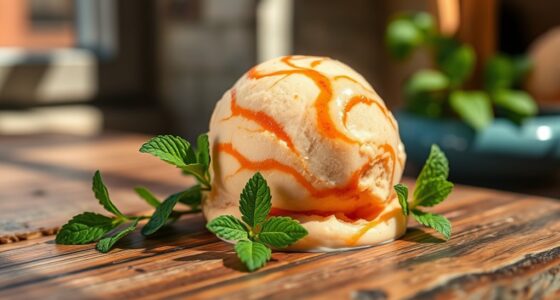Brazilian açaí gelato bowls are both a popular superfood trend and a reflection of Amazonian culture. They connect you to indigenous traditions while embracing a health-conscious lifestyle. But be aware, increased demand can threaten ecosystems if not sourced sustainably. Supporting responsible brands helps preserve this cultural heritage and protect the environment. Curious about how this vibrant dish balances tradition with modern health trends? Keep exploring to discover more.
Key Takeaways
- Açaí bowls originated from Amazonian indigenous traditions and have become a popular health-focused trend worldwide.
- The global surge in demand has raised concerns about sustainable harvesting and environmental impacts in the Amazon.
- Ethical sourcing and supporting local communities are essential to preserving the cultural and ecological integrity of açaí production.
- While açaí bowls are now mainstream, they still represent a connection to Amazonian heritage and traditional superfoods.
- Consumers can influence whether açaí remains a cultural staple or just a fleeting health trend through their purchasing choices.

Brazilian Açaí Gelato Bowls offer a delicious and invigorating way to enjoy the superfood’s vibrant flavors. As you immerse yourself in this trendy treat, it’s essential to reflect on not just the taste but also the broader implications behind its popularity. Açaí, originating from the Amazon rainforest, carries a deep cultural significance for many indigenous communities. For them, it’s more than just a food; it’s part of their heritage, symbolizing tradition, identity, and sustenance. When you indulge in açaí bowls, you connect with this cultural history, but it’s also worth asking how this tradition is being preserved and respected amid increasing global demand.
Sustainability concerns play a significant role in the popularity of açaí bowls today. As demand skyrockets, the environmental impact of harvesting açaí berries can become problematic. Overharvesting can threaten local ecosystems, disrupt biodiversity, and deplete resources that indigenous communities rely on. Large-scale commercial production often relies on monoculture farming practices, which can lead to soil degradation and water management issues. When you choose açaí products, it’s wise to look for brands that prioritize sustainable sourcing and fair trade practices. Supporting those committed to environmentally responsible harvesting helps ensure that the rainforest’s delicate balance isn’t compromised and that indigenous communities retain control over their resources.
The cultural significance of açaí also raises questions about cultural appropriation and economic fairness. While the superfood’s popularity boosts local economies, it can sometimes lead to exploitation or misrepresentation of indigenous traditions. You might notice that commercial açaí bowls are often marketed globally with little acknowledgment of their Amazonian roots. By being conscious of where your açaí comes from, you help promote respect for the cultural heritage tied to this superfood. Purchasing from companies that collaborate directly with local producers or support community development can make your indulgence more meaningful and ethical.
In essence, enjoying açaí gelato bowls isn’t just about savoring a tasty treat; it’s about engaging with a complex web of environmental and cultural issues. You have the power to influence the sustainability of the resource and honor the cultural significance behind it. You can also support initiatives that promote cultural preservation and environmentally sustainable practices. As this superfood continues to gain mainstream appeal, your choices—such as selecting ethically sourced, eco-friendly options—can help ensure that the tradition and environment surrounding açaí are preserved for generations to come. So, while you indulge, remember that your consumption can support both the health of the planet and the cultural heritage embedded in this Amazonian treasure.
Frequently Asked Questions
How Does Acai Compare Nutritionally to Other Superfoods?
When comparing acai to other superfoods, you’ll find it boasts a high antioxidant capacity that helps combat free radicals. Its nutrient density provides healthy fats, fiber, and vitamins, making it a great addition to your diet. While other superfoods like blueberries or chia seeds also offer health benefits, acai’s unique blend of antioxidants and nutrients makes it stand out, supporting overall wellness and vigor.
Are Acai Bowls Suitable for All Dietary Restrictions?
Like a chameleon adapting to its environment, acai bowls can suit many dietary needs. If you have dairy restrictions, you can opt for dairy alternatives like almond or coconut milk. For gluten sensitivities, many bowls are naturally gluten-free, but always watch for added toppings. With thoughtful choices, you can enjoy acai bowls without compromising your dietary restrictions, making them a versatile, inclusive treat.
What Is the Environmental Impact of Acai Production?
You might wonder about acai’s environmental impact, especially regarding sustainable harvesting and its carbon footprint. When produced responsibly, acai supports local communities and minimizes ecological harm. However, unsustainable practices can lead to deforestation and increased emissions. As a consumer, you can choose brands committed to eco-friendly sourcing, helping reduce the overall carbon footprint and promote sustainable harvesting, ensuring acai remains a positive part of your diet without harming the environment.
Can Acai Bowls Help With Specific Health Conditions?
Imagine a vibrant acai bowl, bursting with color and flavor—could it help with your health? If you have acai allergies, you should be cautious, but for others, acai offers detox benefits that may support digestion and energy levels. While it’s not a cure-all, incorporating acai into your diet might aid your wellness goals, but always check for allergies and consult a healthcare professional first.
How Long Do Acai Gelato Bowls Stay Fresh?
If you wonder how long acai gelato bowls stay fresh, it depends on storage tips and the shelf life. Typically, you should consume them within 24 hours if kept refrigerated to maintain freshness and prevent spoilage. For longer storage, freeze the bowls, but note that texture and flavor might change. Always cover tightly and store at or below 0°F (-18°C) for best results.
Conclusion
As you immerse yourself in açaí gelato bowls, think of them as a vibrant rainforest in a bowl—rich, colorful, and full of life. Just like how I once watched a friend transform her mornings with one, turning her routine into a daily adventure, these bowls can be your energizing escape. Whether they’re a fleeting trend or a lasting staple, they remind us that healthy choices can be both delicious and exciting. So, why not embrace the superfood wave?















